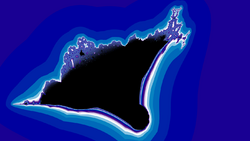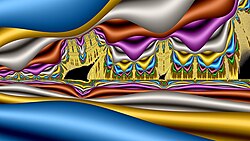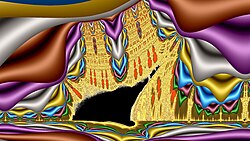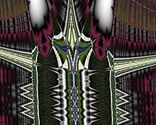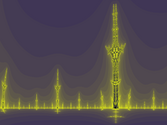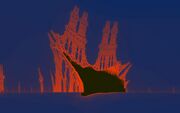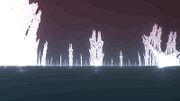Burning Ship fractal
The Burning Ship fractal, first described and created by Michael Michelitsch and Otto E. Rössler in 1992, is generated by iterating the function:
- [math]\displaystyle{ z_{n+1} = (|\operatorname{Re} \left(z_n\right)|+i|\operatorname{Im} \left(z_n\right)|)^2 + c, \quad z_0=0 }[/math]
in the complex plane [math]\displaystyle{ \mathbb{C} }[/math] which will either escape or remain bounded. The difference between this calculation and that for the Mandelbrot set is that the real and imaginary components are set to their respective absolute values before squaring at each iteration. The mapping is non-analytic because its real and imaginary parts do not obey the Cauchy–Riemann equations.[1] Note that virtually all images of the Burning Ship fractal are reflected across the [math]\displaystyle{ y }[/math]-axis for aesthetic purposes, and some are also reflected across the [math]\displaystyle{ x }[/math]-axis.[2]
Implementation
The below pseudocode implementation hardcodes the complex operations for Z. Consider implementing complex number operations to allow for more dynamic and reusable code.
for each pixel (x, y) on the screen, do:
x := scaled x coordinate of pixel (scaled to lie in the Mandelbrot X scale (-2.5, 1))
y := scaled y coordinate of pixel (scaled to lie in the Mandelbrot Y scale (-1, 1))
zx := x // zx represents the real part of z
zy := y // zy represents the imaginary part of z
iteration := 0
max_iteration := 100
while (zx*zx + zy*zy < 4 and iteration < max_iteration) do
xtemp := zx*zx - zy*zy + x
zy := abs(2*zx*zy) + y // abs returns the absolute value
zx := xtemp
iteration := iteration + 1
if iteration = max_iteration then // Belongs to the set
return insideColor
return (max_iteration / iteration) × color
References
- ↑ Michael Michelitsch and Otto E. Rössler (1992). "The "Burning Ship" and Its Quasi-Julia Sets". In: Computers & Graphics Vol. 16, No. 4, pp. 435–438, 1992. Reprinted in Clifford A. Pickover Ed. (1998). Chaos and Fractals: A Computer Graphical Journey — A 10 Year Compilation of Advanced Research. Amsterdam, Netherlands: Elsevier. ISBN:0-444-50002-2
- ↑ https://www.hpdz.net/StillImages/BurningShip.htm
External links
| Wikimedia Commons has media related to Burning Ship fractal. |
- About properties and symmetries of the Burning Ship fractal, featured by Theory.org
- Burning Ship Fractal, Description and C source code.
- Burning Ship with its Mset of higher powers and Julia Sets
- Burningship, Video,
- Fractal webpage includes the first representations and the original paper cited above on the Burning Ship fractal.
- 3D representations of the Burning Ship fractal
- FractalTS Mandelbrot, Burning ship and corresponding Julia set generator.
 |


